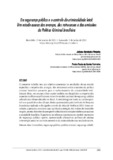Security in SDN: A comprehensive survey

Compartir este ítem
Autor
Correa Chica J.C.
Imbachi J.C.
Botero Vega J.F.
Citación
Metadatos
Mostrar el registro completo del ítemResumen
Software Defined Networking (SDN) is a revolutionary paradigm that is maturing along with other network technologies in the next-gen trend. The separation of control and data planes in SDN enables the emergence of novel network features like centralized flow management and network programmability that encourage the introduction of new and enhanced network functions in order to improve prominent network deployment aspects such as flexibility, scalability, network-wide visibility and cost-effectiveness. Although SDN exhibits a rapid evolution that is shaping this technology as a key enabler for future implementations in heterogeneous network scenarios, namely, datacenters, ISPs, corporate, academic and home; the technology is far from being considered secure and dependable to this day which inhibits its agile adoption. In recent years, the scientific community has been attracted to explore the field of SDN security to close the gap to SDN adoption. A twofold research context has been identified: on the one hand, leveraging SDN features to enhance security; while on the other hand one can find the pursue of a secure SDN system architecture. This article includes a description of security threats that menace SDN and a list of attacks that take advantage of vulnerabilities and misconfigurations in SDN constitutive elements. Accordingly, a discussion emphasizing the duality SDN-for-security and SDN-security is also presented. A comprehensive review of state-of-the art is accompanied by a categorization of the current research literature in a taxonomy that highlights the main characteristics and contributions of each proposal. Finally, the identified urgent needs and less explored topics are used to outline the opportunities and future challenges in the field of SDN security. © 2020 Elsevier Ltd
Colecciones
- Indexados Scopus [1632]
Ítems relacionados
Mostrando ítems relacionados por Título, Autor o Palabra clave.
-
Internet of things electromechanical method and device for new or installed gas stoves: Making home safier
Gonzalez-Palacio M.; Luna-Delrisco M.; Gonzalez-Palacio L.; Cuatindioy-Imbachi J.; Quiza-Montealegre J.J.; Arrieta-Gonzalez C.; Villegas-Moncada S.; Arredondo C.; Quintero F.Electronic devices have been dabbled into houses to perform automatic tasks and fulfill different needs such as illumination, cooking, air conditioning, surveillance, among others. Furthermore, those elements can collect ... -
Memberships Networks for High-Dimensional Fuzzy Clustering Visualization
Ariza-Jiménez L.; Villa L.F.; Quintero O.L.Visualizing the cluster structure of high-dimensional data is a non-trivial task that must be able to deal with the large dimensionality of the input data. Unlike hard clustering structures, visualization of fuzzy clusterings ... -
Public Security and the Control of Lethal Crime: a Study on the Advancements, Throwbacks and Omissions of the Brazilian Criminal Policy
da Cunha Ferreira, Pedro Paulo; Nominato Pimenta, Juliana (MedellínUniversidad de MedellínUniversidad de MedellínFacultad de DerechoMedellín, 2022-10-03)The present work aims to present the results of a specific study on the advancements, throwbacks and omissions of the Brazilian criminal policy proposed to combat lethal crime. Moreover, its critical examination implies a ...

